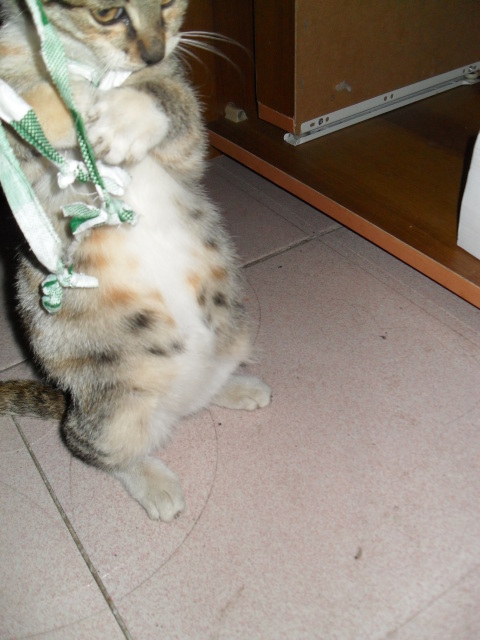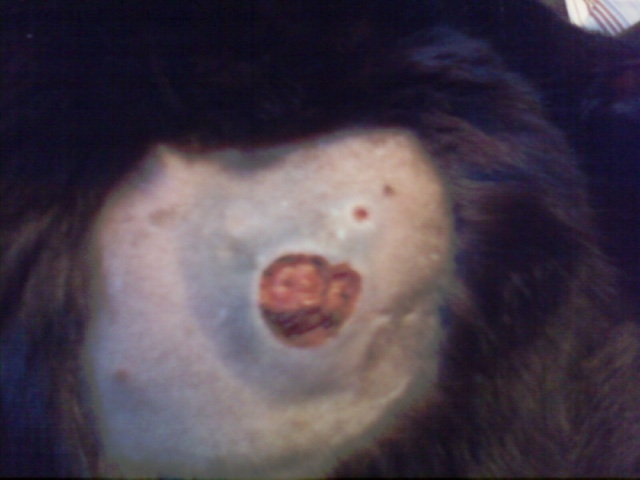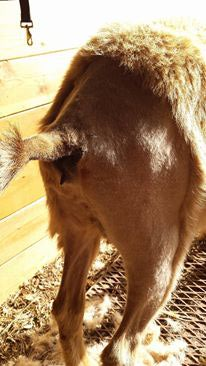Questionmy cat just had babies 3 days ago im wondering wat i can use on her to kill the fleas and not harm the babies at the same time
AnswerThere is really not much you can do at this point. Anything you put on the cat will be toxic to the kittens. The best thing you can do is sit down and comb her with a flea comb and then dip the comb (with fleas in it) in a bowl of liquid dish soap with water.
Keep combing and combing her until the fleas are far and few in between.
The dish soap kills the fleas and drowns them also. You can comb the kittens too if you want. When they are about 6 weeks old you can get some Ovitrol and spray the mom, the bedding and the kittens, but I get a rag and spray the rag then wipe them down. Be sure to wipe between their eyes- that is where a lot of the fleas run to.
Ovitrol is an IGR and will kill the adults, make the eggs not hatch and keep the larvae from turning into cocoons. Once the fleas emerge from the cocoon however, (the ones that were already in there) you can kill them with the spray. But this is after the kittens are older.
You can move mom and kittens indoors or where ever they are and treat the area for fleas but you MUST wait a few days before putting them back. Remember that 90% of your flea problem is not the adults you are seeing, but the eggs, larvae and cocoons.
Here is a link to the flea pyramid:
http://www.flea-info.com/cab/en/cat_fleas_lifecycle.shtml
and here are some tips for managing fleas without pesticides:
Managing the Fleas' Environment
At any given time, fleas may be present in any or all four life cycle stages. Thus an effective program must address the flea at all four stages of development. Vacuuming areas your pet frequents, bathing your pet, washing pet bedding, and combing for fleas can effectively keep your flea population at a tolerable level. It is important to recognize that as the flea population rises and falls, physical control measures must be adjusted accordingly.
Fleas tend to accumulate where pets sleep. If possible, establish a single, regular sleeping place with bedding that is easily removable and washable. Wash bedding about once a week to break up the flea life cycle. A towel or blanket makes excellent bedding. Pick bedding up by the four corners so that eggs and larvae aren't scattered throughout the area.17,19
Pet access to hard-to-clean areas like basements and attics must be restricted. Access to bedrooms where a flea infestation would be particularly annoying can also be limited. Since pets bring in fleas from outside, consider the possibility of having either an inside or an outside pet.
If your pet does go in and out of the house, keep your lawn cut short and either very dry or very wet. Fleas don't do well in either extreme.
Regularly use a flea comb on your pet. The fleas are caught in the closely spaced tines of the comb and can be flicked into a container of soapy water where they drown. Dish soap works well. Don't crush fleas with your fingers since they carry parasites and disease organisms.20
Many pets actually come to enjoy this grooming process. You can monitor the extent of your flea population by keeping a count of fleas captured during these combing sessions. A rising flea count will herald an increasing flea population in time for you to take preventive measures. Flea combs come in a variety of sizes and are available in most pet supply stores.
Bathe your pet. It's not necessary to use insecticidal shampoos; most soaps will kill fleas. Read the label; frequently all the ingredients are listed. Test your favorite shampoo or soap by mixing it with water and dropping a few fleas from your flea comb into it. Fleas should die within seconds. Some soaps are strong desiccants so be sure to monitor your pet's hair and skin. Change products if your pet's skin becomes dry and itchy.
Vacuuming floors, carpets, furniture, crevices and cracks once a week is an excellent means of controlling the flea population. Vacuuming is especially effective at picking adults and eggs. The vibration from vacuuming can result in the emergence of adult fleas from the pupal stage. The newly hatched fleas are vacuumed up prior to ever meeting you or your pet. However, vacuuming is not particularly effective in removing the flea larvae in carpeting. Larvae wrap themselves around the base of carpet fibers, and hang on.
Vacuum more frequently if the flea population increases, every two or three days during peak season. After vacuuming, the bag must be dealt with immediately or the fleas will escape and reinfest the area. The bag can be thrown away, burned or placed in a sealed black plastic bag in the freezer or in the sun for several days. A water vacuum eliminates the need to deal with the vacuum cleaner bag.
If you have a high level flea infestation, having your carpets professionally steam-cleaned may be worth the investment. Steam-cleaning kills fleas in the adult and larval stages. However, the steam can trigger the hatching of the remaining flea eggs a few days later.
Raising temperatures within a structure can kill the fleas. Isothermics Inc., of Anaheim, California, sells a heating unit that raises the temperature in a structure to the point where it kills fleas and other insects (termites, cockroaches and ants) without damaging the house or its contents. This technology is available only to pest control operators.
Flea Traps
Flea population explosions tend to occur when their food sources are on vacation. How often have you and your pet come home from a relaxing trip only to be assaulted by a horde of ravenous fleas? You might want to try leaving behind a flea trap. Traps can also reduce flea populations when used routinely in rooms where flea populations are high.
Good luck and I hope you can conquer the flea problem. Too many fleas on your kittens can actually kill them by making them anemic and it can do the same thing to your cat. She also needs to be free fed a HIGH quality cat food like Science Diet Kitten Growth, then when the kittens are weaned you can just leave it down for them too.
Then when they are 6 weeks old get the Mom in to be spayed and you won't have to deal with this or overpopulating the area with cats.
Send me a photo of the kittens!

 Feral cat with bloated stomach
Question
Cats stomach
Hello,
Id like some help with a
Feral cat with bloated stomach
Question
Cats stomach
Hello,
Id like some help with a
 My dogs chronic ear allergy infections
Question
Hiedi
My dog whom is three years now-part Aust
My dogs chronic ear allergy infections
Question
Hiedi
My dog whom is three years now-part Aust
 sick little puggie
Question
lola
My year old chug (chihuahua pug cr
sick little puggie
Question
lola
My year old chug (chihuahua pug cr
 Blue Skin Around Abscess
Question
Kittys Wound
A few weeks ago we noticed
Blue Skin Around Abscess
Question
Kittys Wound
A few weeks ago we noticed
 Goat Pregnancy
Question
Hoots back end Hoots bag
I have a
Goat Pregnancy
Question
Hoots back end Hoots bag
I have a